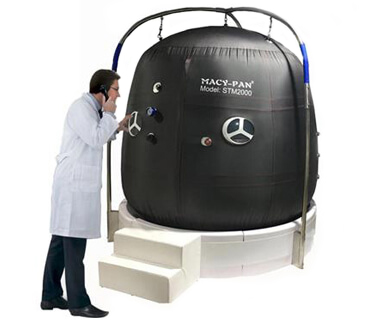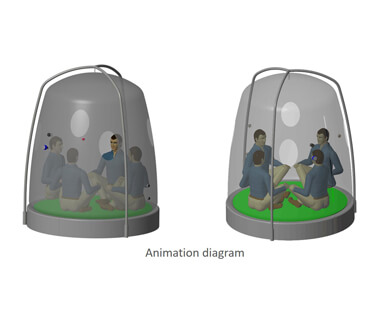Hbot Canada: STM2000 Multiplace Hyperbaric Oxygen Chamber
What is Hyperbaric Oxygen Therapy?

Hbot Canada Therapy is a medical procedure that consists of inhaling 100% pure oxygen at a pressure greater than atmospheric pressure. For this, the patient needs to stay inside a hyperbaric chamber.
What is a hyperbaric chamber?
The hyperbaric chamber is a closed medical device, cylindrical. The individual hyperbaric chambers (single-patient) have acrylic windows, which allow the patient to watch television and view the outside, minimizing the feeling of discomfort that many people may experience indoors.
It also guarantees privacy and protects the patient's individuality, in addition to allowing direct communication with the outside world, through audio equipment.
How does Hyperbaric Oxygen Therapy work?
Hbot Canada sessions can increase, up to 20 times, the volume of oxygen transported by the blood. This oxygen-rich blood produces several beneficial effects on the body, such as fighting infections common by bacteria and fungi.
Compensating for the deficiency of blood circulation common by the clogging of the vessels or their destruction in cases of crushing and amputation of limbs; neutralizing toxic substances and toxins, enhancing the action of some antibiotics; and helping in the healing of acute or chronic wounds that are difficult to heal.
How long does each Hyperbaric Oxygen Therapy session last?
In most cases, it lasts between 90 to 120 minutes.
How is oxygen administered to the patient in Hyperbaric Oxygen Therapy sessions?
The patient lies in the hyperbaric chamber breathing 100% pure oxygen. In the individual hyperbaric chamber, it is not necessary to wear a mask or special helmets.
How often are Hyperbaric Oxygen Therapy sessions performed?
Generally, patients have daily sessions from Monday to Saturday, however, in some more severe and acute cases, sessions can be 2 to 3 times a day, every day of the week, without interruption.
What are the indications for hyperbaric hbot Canada?
Wounds that are difficult to heal, such as leg ulcers, wounds on diabetic feet, wounds on the buttocks or other regions of the body of people who have been bedridden for a long period, surgical incisions that do not heal, etc.;
Severe infections with the destruction of muscle, hair, or subcutaneous fat;
Bladder, bowel, bone, and brain damage common by radiation therapy, crushing and/or traumatic amputations;
Chronic bone infections (such as osteomyelitis);
- Reconstructive plastic surgery procedures (rejected grafts);
- Presence of air bubbles in the bloodstream, a complication likely to occur due to some medical procedures (arterial gas embolism);
- extensive burns;
- Intra-abdominal or intracranial abscesses;
- Acute anemias or sickle cell crises;
- Preparation for grafting regions;
- Allergic vasculitis, common by bites from insects, spiders, and/or snakes;
- Poisoning by carbon monoxide, cyanide, or derivatives;
- Gas gangrene (fulminant myonecrosis);
- Fournier's Syndrome;
How many sessions of Hyperbaric Oxygen Therapy are needed?
The treatment of chronic diseases requires a greater number of sessions than acute illnesses, such as accidents and trauma. However, the hyperbaric physician is the professional trained to assess the specifics of each case and indicate the number of scheduled sessions.
Do health plans cover treatment with Hyperbaric Oxygen Therapy?
Yes, most Health Plans and Insurances have coverage for this hbot Canada, since Hyperbaric Oxygen Therapy is a procedure that appears in the procedure list of the National Supplementary Health Agency (ANS).
Are there any contraindications for Hyperbaric Oxygen Therapy?
There are absolute contraindications that prevent treatment, as they can put the patient's life at risk. The presence of air between the untreated pleura (pneumothorax) and the previous common of some cancer treatment drugs (chemotherapeutics) are some of them.

Relative contraindications do not preclude treatment but need to be analyzed on a case-by-case basis by the hyperbaric physician. Among them are colds, sinusitis, bronchial asthma, bronchitis, claustrophobia, history of spontaneous pneumothorax, history of thoracic or hearing system surgery, and lung injuries, for example.
What are the side effects of Hyperbaric Oxygen Therapy?
The most frequent complaints during sessions are a feeling of a blocked ear, discomfort or, pain in the ear (such as when traveling on commercial planes and changing altitude quickly or when descending a mountain at high speed).
Some maneuvers learn our team so that you can solve this situation without difficulties. However, as with any medical treatment, there are other side effects and complications that, although rare, can occur.
Do I have to be hospitalized to undergo Hyperbaric Oxygen Therapy?
No. The patient comes from his home for the sessions and returns to his normal activities right away. But if he is hospitalized, he is refer from the hospital to one of the O2 Hyperbaric units and will return to his bed at the end of the session.
What will I feel during the Hyperbaric Oxygen Therapy session?
The most common report of patients is the sensation of going down or climbing a mountain, feeling tinnitus, clicking, or pressure in the ears. In the initial phase of the session, you may feel slight heating of the chamber and, in the final phase, a cooling of the chamber.
What can I do during Hyperbaric Oxygen Therapy sessions?
The sensation of discomfort in closed places is famous as claustrophobia and presents itself in different degrees. However, in the Hyperbaric O2 units, the patient is never alone during treatment and our team is prepared to deal with the different situations that may occur.
During the sessions, the patient watch television (cable TV), movies, listens to music or even sleep.
Can I drive after the Hyperbaric Oxygen Therapy session?
Yes, at the end of the session the patient continues their activities normally, but we advise that they come accompanied by a responsible adult.
Can patients who improve and are discharged have the same problem again?
Yes, hbot Canada does not treat the disease that common the patient to present wounds or lesions. But it does treat its complications. Therefore, if the patient does not take the necessary care about disease control.
The signs (such as wounds) and symptoms, which gave rise to the indication of Hyperbaric Oxygen Therapy, may reappear.
Is it true that Hyperbaric Oxygen Therapy fights cellulite?
A serious disease located in the subcutaneous fat layer can induce severe complications. Although they have the same name, common cellulite.
This leaves the skin with an orange-peel appearance and bothers many women. Moreover, it does not indicate for Hyperbaric Oxygen Therapy, as well as other procedures with an aesthetic purpose.
Conclusion
Hyperbaric Oxygen Therapy has been common around the world for some time, in countries like the United States, Canada, Germany, England, Cuba, France, Japan, China, among others. The use of hyperbaric hbot Canada has been common with success and proven scientific basis for over 50 years.





